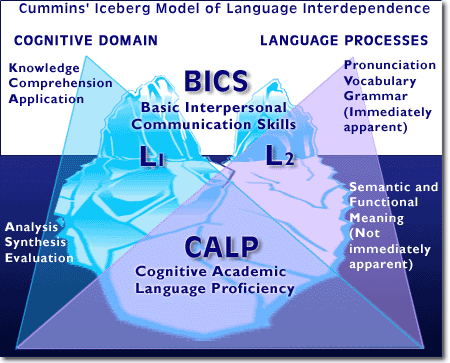
Academic
Language
Academic Language
Academic language is defined by some many different people in so many different ways. Some believe this it is just language spoken in schools. Others believe that there is way more to it than that. So, what is it? Colorín Colorado states that academic language is the language used in the classroom, workplace, text, assessments, academic success, and power. PACT defines academic language as "the language needed by students to do the work in schools. It includes, for example, discipline-specific vocabulary, grammar and punctuation, and applications of rhetorical conventions and devices that are typical for a content area." Even the Glossary of Education Reform defines academic language, saying it "refers to the oral, written, auditory, and visual language proficiency required to learn effectively in schools and academic programs—i.e., it’s the language used in classroom lessons, books, tests, and assignments, and it’s the language that students are expected to learn and achieve fluency in." Another definition for academic language comes from Maxwell, who defines it as "the language of texts. The forms of speech and written discourse that are linguistic resources educated people in our society can draw on. This is language that is capable of supporting complex thought, argumentation, literacy, successful learning; it is the language used in written and spoken communication in college and beyond." (Maxwell, 2018). The document on the side is her piece on Common Core and how the standards are changing for Emergent Bilinguals and English-language learners.
Cummins has also addressed what he thinks academic language is. He recognizes CALP as academic language, which is found below.
Cummins' BICS vs. CALP
BICS: Basic Interpersonal Communication Skills
BICS is language that is used in conversation and in more informal interactions. Because of this, BICS is easier to understand and very simple to use. With this in mind, most of what students do every day is use BICS, informal conversations. So, we need to make sure as teachers to validate their social growth with BICS. It can be hard for students to speech to others with CALP, so make sure to just encourage speaking with BICS too.
CALP: Cognitive Academic Language Proficiency
CALP is language that is used in a classroom, so it must be understood and discussed. This language has more critical thinking involved, more abstract ideas, and is more challenging. This is formal and is usually used to discuss content. So as teachers, we need to make sure to teach the students academic language (especially if you plan to use it in the classroom more).

With Cummins' Iceberg Model (shown below), CALP is seen as the part of the iceberg that is submerged under water. This is because CALP, as academic language, is going deeper into the growth of language and is the support of BICS. BICS is seen as the surface level aspects of language, and how it is easier to see. This model also goes hand-in-hand with CUP, the Common Underlying Proficiency.

Critiques of Cummins' BICS vs. CALP
On the document BICS and CALP (found on the button above), it shares three critiques:
-
"The conversational/academic language distinction reflects an autonomous perspective on language that ignores its location in social practices and power relations (Edelsky et al., 1983; Wiley, 1996).
-
CALP or academic language proficiency represents little more than “test-wiseness” - it is an artifact of the inappropriate way in which it has been measured (Edelsky et al., 1983).
-
The notion of CALP promotes a “deficit theory” as it attributes the academic failure of bilingual/minority students to low cognitive/academic proficiency rather than to inappropriate schooling (Edelsky, 1990; Edelsky et al., 1983; Martin-Jones & Romaine, 1986). "
So, CALP can be hard because it can throw off language learners when they are developing language. It a word or phrase is something that is not familiar because it is used for a certain content areas or is used in a job setting. So, students might struggle with CALP.
WIDA's Academic Language Definition
WIDA is the foundation that help support multilingual in their language learning. They have also said they that try to create equitable learning experiences for these kids, and create standards and assessments that fit to their learning.
For Academic Language, they have put it into different contexts. These are Discourse - with Linguistic Complexity, Sentence - with Language Forms and Conventions, and Word/Phrase - with Vocabulary Usage.
The button down below takes you to WIDA's description of Academic language, and what the features are. Or, you can see it in the table down below. Either way, WIDA sees academic language that follows structures called discourse, sentences, and words/phrases.

Citations:
-
Google. (n.d.). BICS/CALP - Basic Tips and Information for Starting Bilingual Educators. Retrieved February 17, 2019, from https://sites.google.com/site/tipsandinfobilingedu/information
-
Herr, N. (n.d.). Academic Language - Defined by PACT. Retrieved February 17, 2019, from https://www.csun.edu/science/ref/language/pact-academic-language.html
-
Maxwell, Lesli A. “Common Core Ratchets Up Language Demands for English-Learners.” Education Week, Editorial Project in Education, 20 June 2018, www.edweek.org/ew/articles/2013/10/30/10cc-academiclanguage.h33.html?tkn=LMDGIyyzaSaA9s8wITywjzHxCIYpREQ4F9uP&cmp=clp-lydia-slu&print=1.
-
Partnership, G. S. (2013, August 29). Academic Language Definition. Retrieved February 17, 2019, from https://www.edglossary.org/academic-language/
-
WIDA. (n.d.). Language for Learning. Retrieved February 17, 2019, from https://wida.wisc.edu/teach/language-learning
-
Wright, W. E. (2015). Foundations for teaching English language learners: Research, theory, and practice (2nd ed.). Philadelphia: Caslon.